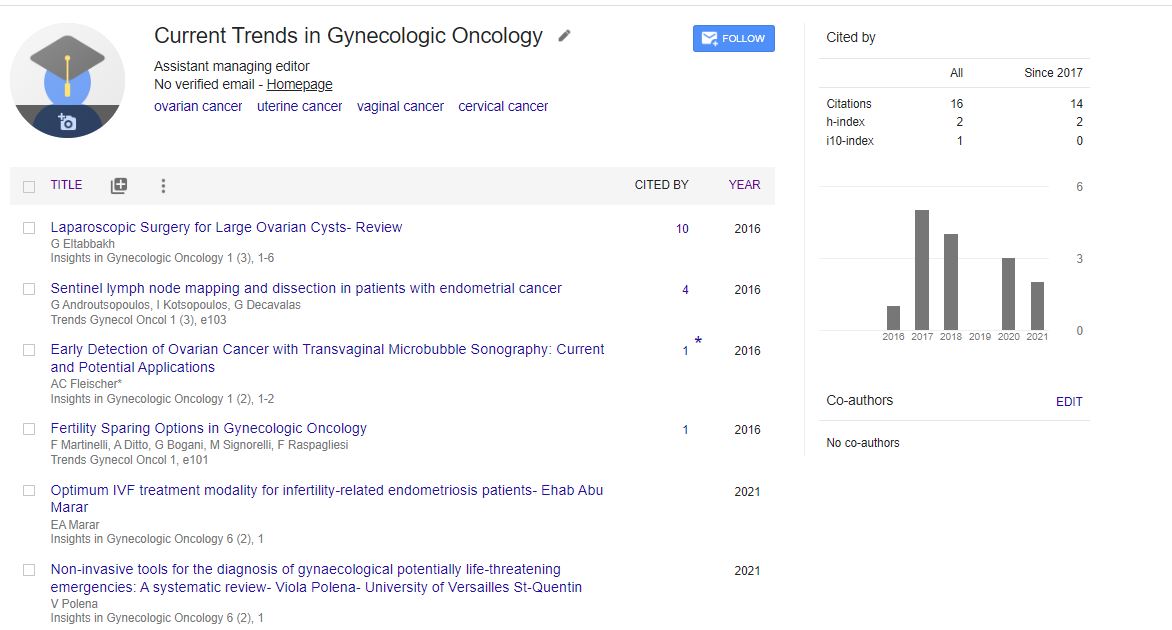Non-invasive tools for the diagnosis of gynaecological potentially life-threatening emergencies: A systematic review- Viola Polena- University of Versailles St-Quentin
*Corresponding Author:
Copyright: © 2021 . This is an open-access article distributed under the terms of the Creative Commons Attribution License, which permits unrestricted use, distribution, and reproduction in any medium, provided the original author and source are credited.
Abstract
Background: The prompt and accurate diagnosis of gynaecological potentially life-threatening pathologies (G-PLE) like complicated ectopic pregnancy (C-EP: ruptured ectopic pregnancy), complicated pelvic inflammatory disease (C-PID: tuboovarian abscess & pyosalpinx), adnexal torsion (AT) and hemoperitoneum (HmPT) of any gynaecological origin is crucial for reducing the morbidity and mortality associated with these conditions. Objective: To systematically identify non-invasive tools for the diagnosis of any G-PLE described in the literature and to assess their diagnostic accuracy. Methods: It was searched the following electronic databases from 1990 to December 2012: MEDLINE; EMBASE; Cochrane Central Register of Controlled Trials (CENTRAL; The Cochrane Library) for English or French language publications reporting on the diagnosis of G-PLE. Studies were eligible if they were diagnostic studies of all designs, with a gold standard, with sufficient information to allow the construction of a contingency table, in which at least one of the G-PLE was concerned. Two of authors (VP, CVR) working independently used a standardized data collection form to extract data from each selected study and assessed the quality of each study using QUADAS 2 tool. Results: It was identified 8288 reports of diagnostic studies concerning the G-PLE and 45 articles were suitable for systematic review. The most common diagnostic tool evaluated was transvaginal ultrasound (20/45, 44%) followed by medical history (18/45, 40%). Clinical examination (vital signs, abdominal palpation, bimanual examination) was evaluated in 15 (33%) and laboratory tests (blood count, B-hCG, CRP) in 14 (31%). Through different evaluated signs, 7 ultrasound signs, as well as, the identification of a mass by abdominal palpation or vaginal examination, the measure of systolic blood pressure, the rates of Hb, presented significant diagnostic performances of clinical utility (Se ≥95% & LR - ≤0.25, or Sp ≥90% & LR+ ≥4). Abnormal Doppler findings highly suggest an adnexal torsion with both a good sensibility (range: 76%; 100%) and specificity (range: 94%; 100%), while free pelvic fluid highly suggest a ruptured ectopic pregnancy or hemoperitoneum with a specificity range through the studies of 91%; 100%. Conclusions: In conclusion, the results of this systematic review suggest that non-invasive diagnostic tools and the skill set for clinicians required to deal with different G-PLEs are essentially the same. Medical history and symptoms contribute in the selection of patients with suspected G-PLEs. Assessment of vital signs, as well as clinical examination, ultrasound and laboratory tests should be considered in women with suspected G-PLE, in predicting the presence of G-PLEs. However, no clinical finding or test is reliable sufficiently for detecting G-PLEs. So, they should be incorporated within a diagnostic model in conjunction with other tests. Obtained results highly support the use of ultrasound.

 Spanish
Spanish  Chinese
Chinese  Russian
Russian  German
German  French
French  Japanese
Japanese  Portuguese
Portuguese  Hindi
Hindi 